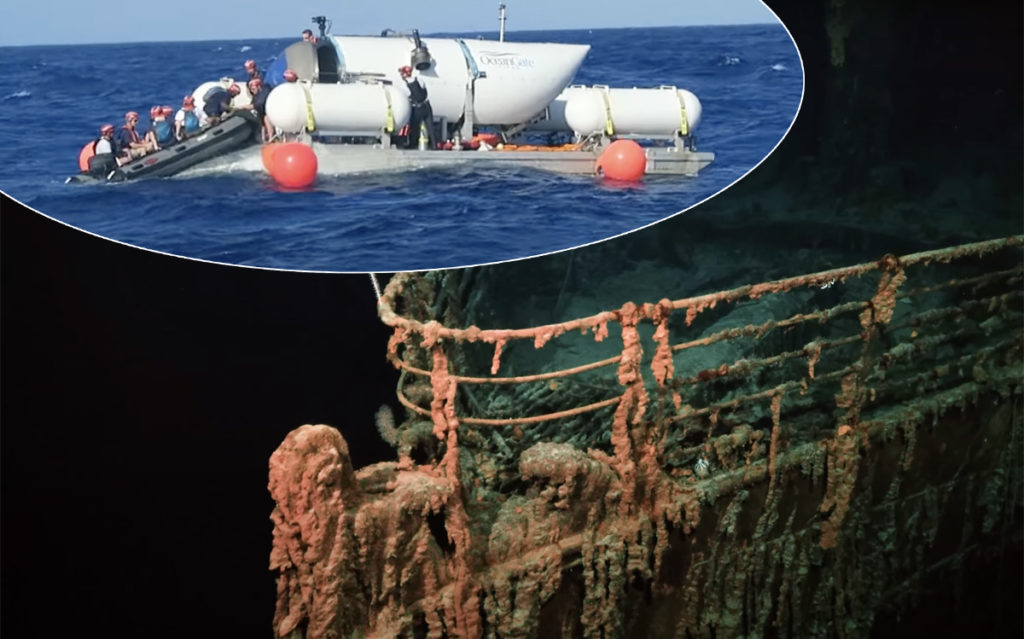The Titanic-bound tourist submarine that has gone missing somewhere in the depths of the Atlantic Ocean may have been the source of eerie “banging sounds” picked up by sonar equipment in recent days.
According to a newly-unearthed government memo on the matter, rescue crews heard “banging sounds” spread out in roughly 30-minute intervals early this week. Those sounds were coming from the depths of the ocean near where the OceanGate Expeditions sub first went missing on Sunday morning.
Related: Four Missing Children Found Alive 40 Days After Plane Crash Deep In The Amazon!
Per Rolling Stone, which first obtained an “internal email” sent to the Department of Homeland Security, government officials reported that search and rescue crews heard the banging sounds while combing the ocean floor using high-powered sonar equipment.
Referencing the Royal Canadian Air Force — which has deployed a P-8 Poseidon reconnaissance aircraft to aid in the ocean search — the email reportedly read:
“RCC Halifax launched a P-8 Poseidon, which has underwater detection capabilities from the air. The P-8 deployed sonobuoys, which reported a contact in a position close to the distress position. The P-8 heard banging sounds in the area every 30 minutes. Four hours later additional sonar was deployed, and banging was still heard.”
Whoa…
And the banging sounds apparently didn’t stop there, either. According to CNN, which reported a second email sent via American federal government officials, “additional feedback” was also heard throughout the day on Monday. That email was less specific about what the “feedback” was, but it read:
“Additional acoustic feedback was heard and will assist in vectoring surface assets and also indicating continued hope of survivors.”
Those aren’t the only investigative updates journalists have revealed in the last 24 hours, either.
In addition to the P-8 aircraft, the Royal Canadian Air Force has deployed a P-3 Orion to the site of the sub’s initial dive. The P-3 is also a military reconnaissance plane that can track submarines and submersibles. During its flight across the North Atlantic Ocean, the P-3 located “a white rectangular object in the water,” according to a Wednesday morning update from CNN.
A ship was sent to investigate the presence of that “white rectangular object.” However, before they could reach the site where it was spotted, CNN reports that crew was diverted to investigate the sources of the aforementioned “acoustic feedback” and “banging sounds” instead.
Related: Missing Minnesota Mom’s Remains Found — And Her Baby Daddy Has Been Arrested
Sadly, in a statement to the media late on Tuesday, the US Coast Guard explained that those searches “yielded negative results.” A spokesperson for the Coast Guard went on to add:
“Additionally, the data from the P-3 aircraft has been shared with our U.S. Navy experts for further analysis which will be considered in future search plans.”
As we’ve been reporting, the US Navy has already sent “subject matter experts” and their renowned Flyaway Deep Ocean Salvage System to the scene to assist in pulling up the missing submersible and rescuing its occupants. The aforementioned US Coast Guard and Royal Canadian Air Force have also sent more aircraft and vessels to the area — which is about 900 miles east of Cape Cod, Massachusetts — to continue the search.
Related: Mom Of Missing Girl Arrested After Burned Remains Found In Apartment
Authorities remain hopeful that the banging sounds could suggest the missing people in the submersible are still alive. A former US Navy diver named Bobbie Scholley explained the importance of those sounds being picked up on sonar equipment in an interview earlier this week with CNN:
“The submersible is going to be making sounds itself with the systems on board … the crew, hopefully, are making noises as well. Those sonar buoys are picking up, they’re very good and they’re detecting these noises.”
Scholley continued:
“The hard part is finding the submersible. And once they find the submersible, there are all sorts of situations of how to get that submersible to the surface, and rescue the crew.”
No kidding.
We can only hope they find that submersible and are able to somehow tow it up out of the water. And soon…
Related Posts
CLICK HERE TO COMMENT-
Categories




































